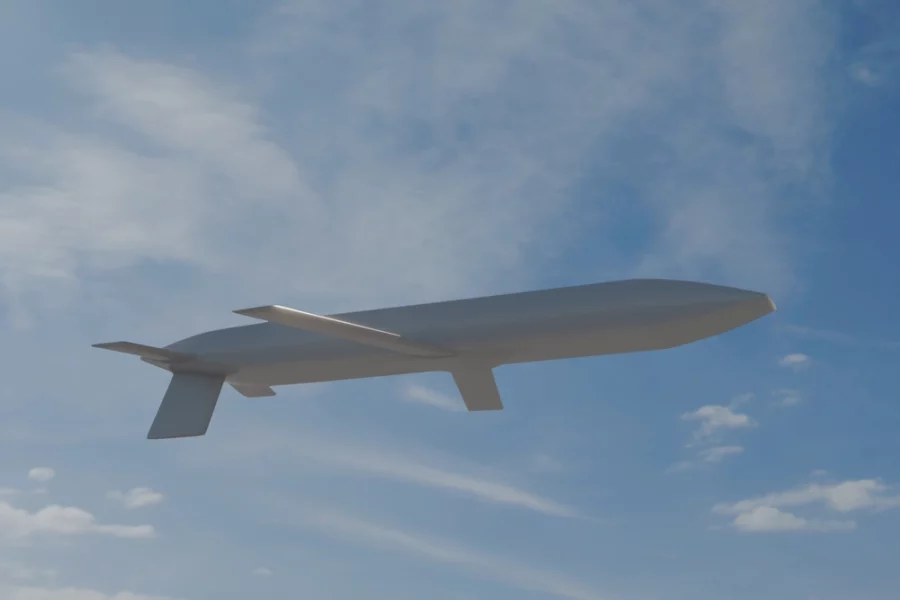The Air Force shared its first-ever concept illustration of the secretive AGM-181 Long-Range Stand-Off missile (LRSO). The missile, being developed by Raytheon, will succeed the AGM-86B ALCM as the B-52’s primary nuclear weapon beginning around 2030.
The image was released on the Pentagon’s media service, Defense Visual Information Distribution Service (DVIDS), without comment on June 2. Little accompanying information was shared, other than to say that it’s an artist’s rendering provided by the Air Force Nuclear Weapon Center.
This first image shows the weapon has a conventional but inverted planform, with anhedral (downward-pointing) wings and elevators and a ventral (bottom-mounted) stabilizer. The wings, elevators and stabilizer edges appear to be designed for stealth, but the nose appears blunt, rather than pointed. The configuration of the tail suggests an exhaust on the upper side of the missile, above the stabilizer, like that on the AGM-158 Joint Air-to-Surface Standoff Missile (JASSM).
Although known to be an air-breathing weapon, no air intake is visible on the bottom-view image, indicating the intake is either on top or its shape has been deliberately obscured for operational security. The Air Force provided images of the JASSM for years that either shielded its bottom air intake from view or showed the missile at such a distance that resolution of the intake’s geometry was impossible. Former service officials called this tactic “hiding in plain sight.”
The LRSO’s size can’t be determined from the image.
The Air Force didn’t provide an immediate answer about the timing of the release. As with most highly classified, low-observable platforms—such as the B-21 bomber—the service withholds imagery until a platform has reached a stage of its development where outside engine runs, captive-carry or powered flights will be visible to non-cleared photographers.
RTX’s Raytheon, which is developing the missile, referred queries about the image to the Air Force.
Raytheon received a $2 billion development contract for the engineering and manufacturing development phase of the LRSO in July, 2021. A decision to move to low-rate production is scheduled for February 2027.
Air Force budget documents for fiscal 2025 show LRSO’s funding set to balloon from $295.5 million in fiscal 2026 to $1.22 billion in fiscal 2027, indicating a planned start to production of a future total of 1,087 units. The most recent unit cost estimate is $14 million per LRSO missile.
The missile passed its critical design review in 2023. It will carry the W80-4 warhead with a selectable yield of up to 150 kilotons. The Air Force has said the LRSO is not a hypersonic weapon, and service officials have suggested its top speed is in the high subsonic range.
The LRSO is the second attempt to replace the ALCM, which entered service in the mid-1980s. The Air Force bought 460 of a planned 1,500 stealthy AGM-129 Advanced Cruise Missiles from Lockheed starting in 1990, but retired the type due to budget cuts and arms control agreements in 2012. The stealthy missile was reportedly difficult and expensive to maintain, explaining why the Air Force retained the older ALCM instead. Since then, the inventory of ALCMs has been reduced several times.
Gen. Thomas Bussiere, head of Global Strike Command, said in early June that the LRSO program is doing well and that he anticipates no delay in its entry into service.
Bussiere said the LRSO has utility even if the Air Force retired its B-52s. “We will always have a…capacity to carry the LRSO,” he said. “My guess is when the B-52J model is retired, there’s going to be another long- range strike platform to do standoff weapons carriage.”


